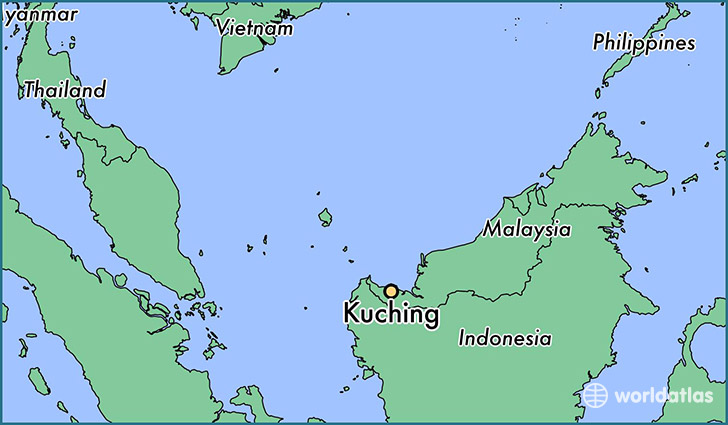Map of Kuching- Malaysia

Kuching, officially the City of Kuching, is the capital and the most populous city in the state of Sarawak in Malaysia. It is also the capital of Kuching Division. The city is situated on the Sarawak River at the southwest tip of the state of Sarawak on the island of Borneo and covers an area of 431 square kilometres (166 sq mi) with a population about 165,642 in the Kuching North administrative region and 159,490 in the Kuching South administrative region—a total of 325,132 people.
Kuching was the third capital of Sarawak in 1827 during the administration of the Bruneian Empire. In 1841, Kuching became the capital of Sarawak after Sarawak was ceded to James Brooke for helping the Bruneian empire in crushing a rebellion particularly the interior borneo dweller Dayak people who later became his loyal followers. The town continued to receive attention and development during the rule of Charles Brooke such as the construction of a sanitation system, hospital, prison, fort, and a bazaar. In 1941, the Brooke administration had a Centenary Celebration in Kuching. During World War II, Kuching was occupied by Japanese forces from 1942 to 1945. The Japanese government set up a Batu Lintang camp near Kuching to hold prisoners of war and civilian internees. After the war, the town survived intact. However, the last Rajah of Sarawak, Sir Charles Vyner Brooke decided to cede Sarawak as part of British Crown Colony in 1946. Kuching remained as capital during the Crown Colony period. After the formation of Malaysia in 1963, Kuching retained its status as state capital and was granted city status in 1988. Since then, the Kuching city is divided into two administrative regions managed by two separate local authorities. The administrative centre of Sarawak state government is located at Wisma Bapa Malaysia, Kuching.
Kuching is a major food destination for tourists and the main gateway for travellers visiting Sarawak and Borneo. Kuching Wetlands National Park is located about 30 kilometres (19 mi) from the city and there are many other tourist attractions in and around Kuching such as Bako National Park, Semenggoh Wildlife Centre, Rainforest World Music Festival (RWMF), state assembly building, The Astana, Fort Margherita, Kuching Cat Museum, and Sarawak State Museum. The city has become one of the major industrial and commercial centres in East Malaysia.
Population
The Malaysian Census 2010 reports that Kuching has a population of 325,132. The city population (North and South) consists of Malays (146,580), Chinese (120,860), Iban (28,691), Bidayuh (13,681), Non-Malaysian citizens (7,216), other Bumiputras (3,250), Melanau (2,078), Indian (1,626) and others (1,140).
Languages
Beside being the capital city of Sarawak, Kuching became a business and cultural centre for the Malays of Sarawak. The dialect of Malay spoken in Kuching is known as Bahasa Sarawak (Sarawakian Malay Language), which is a subset of the Malay language. The dialect used in Kuching is a little different from the dialect used in Miri. Since the second largest population in the city is made up of Han Chinese, the Chinese language is also commonly used, particularly Hokkien, Hakka and Mandarin Chinese. Almost all residents are able to speak English. A number of special private schools that teach English for expatriates child can be found through the city.
Currency
In Kuching the local currency used is the Malaysian Ringgit. Below you will find the exchange rates for the Malaysian Ringgit as used in Kuching, Malaysia.
Geography
Kuching is located on the banks of the Sarawak River in the northwestern part of the island of Borneo. The limits of the City of Kuching include all that area in Kuching District containing an area approximately 431.01 square kilometres (166.41 sq mi) bounded from Gunung Lasak (Mount Lasak) in Muara Tebas to Batu Buaya (Crocodile Rock) in the Santubong peninsula following a series of survey marks as stated in the First Schedule of the City of Kuching Ordinance, 1988. As a simplification of the legal statute, the Kuching city limits extend from the Kuching International Airport in the south to the northern coast of the Santubong and Bako peninsulas; from the Kuching Wetlands National Park in the west to the Kuap River estuary in the east. The Sarawak River generally splits the city into North and South. The highest point in the city is Mount Santubong on the Santubong peninsula, which is at 810.2 metres (2,658 ft) above sea level, located 35 km north of the city centre. Rapid urbanisation has occurred in Greater Kuching and the urban sprawl extends to Penrissen, Kota Sentosa, Kota Padawan, Batu Kawah, Matang, Samariang, Siburan, Tarat, Kota Samarahan, Asajaya as well as Serian which is located about 65 km from Kuching.
Climate
Kuching has a tropical rainforest climate (Köppen climate classification Af), moderately hot but very humid at times and receives substantial rainfall. The average annual rainfall is approximately 4,200 millimetres (170 in).[48] Kuching is the wettest populated area (on average) in Malaysia with an average of 247 rainy days per year. Kuching receives only 5 hours of sunshine per day on average and an average of only 3.7 hours of sunshine per day in the month of January (wettest month of the year). The wettest times are during the North-East Monsoon months of November to February and the city’s driest months are June through August. The temperature in Kuching ranges from 19 °C (66 °F) to 36 °C (97 °F) but the average temperature is around 23 °C (73 °F) in the early hours of the morning and rises to around 33 °C (91 °F) during mid afternoon but the heat index often reaches 42 °C (108 °F) during the “dry season” due to the humidity. This temperature stays almost constant throughout the year if it is not affected by the heavy rain and strong winds during the early hours of the morning which can bring the temperature down to 19 °C (66 °F), but this is very rare.
Economy
Kuching is one of the main industrial and commercial centre for Sarawak. Many state-level, national-level and international commercial banks, as well as some insurance companies establish their headquarters and branches here. The economy is dominated by the primary sector and currently by the tertiary-based industry as the state government want to aim Sarawak to be transform into a developed state by 2020.
There are 3 industrial areas in Kuching, namely Pending Industrial Estate (Mixed and Light Industries), Demak Laut Industrial Park (Mixed, Light, and Medium Industries), and Sama Jaya Free Industrial Zone (Hi-Tech and electronics industry). This is intended to boost the city’s commercial and industrial activity to making it a major growth centre in East Malaysia, as well for the BIMP-EAGA (Brunei-Indonesia-Malaysia-Philippines East ASEAN Growth Area). Kuching hosted numerous national, regional and international conferences, congress and trade fairs, such as the Malaysia Global Business Forum, Tomorrow’s Leaders Summit, International Hydropower Association (IHA) World Congress, ASEAN Tourism Forum, and Routes Asia Conference. Besides, Kuching was chosen as a permanent host for the biennial Asean International Film Festival and Awards (AIFFA). These events are normally held at the Borneo Convention Centre.
Kuching Port Authority (KPA), established in 1961, started its operation at Tanah Puteh Port (Sim Kheng Hong Port) in 1975 with annual capacity of 350,000 tonnes. Its operations has since been shifted to Pending and Senari terminals with annual capacity of 2.9 million tonnes and 7 million tonnes respectively. KPA also controls Biawak Oil Jetty that handles petroleum products.
Historically, the Chinese have contributed to the city economy since their migration during the Brunei Sultanate period after the discovery of antimony ore and also during the Charles Vyner Brooke administration who encouraged the migration of the overseas Chinese to planting black pepper.
Healthcare
There are many types of health services in the city, such as the main public hospitals, public health clinics, other type of health clinics, mobile clinic, flying doctor service, village clinics and 1Malaysia clinic. The main hospital is the Sarawak General Hospital which is the oldest hospital since 1923. Another hospital is Rajah Charles Brooke Memorial Hospital. Hospital Sentosa (Sentosa Mental Hospital), which built with a half-funded from the British Government was opened in 1958, it provides psychiatric services for the entire state and known as the second oldest hospital in Sarawak after the main hospital.
Normah Medical Specialist Centre in Petra Jaya is the largest private hospital with (130 beds) in Sarawak. In addition, three other large private health facilities are Borneo Medical Centre with (120 beds), Timberland Medical Centre with (100 beds), and KPJ Healthcare with (75 beds).
Transportation
Land
Roads in the city are under the jurisdiction and maintenance of either the two local councils, i.e. DBKU (Dewan Bandaraya Kuching Utara) and MBKS (Majlis Bandaraya Kuching Selatan), or the state’s Public Works Department. Roads of the latter category are either state roads or federal roads.
Most major internal roads are dual-carriageways and the city is linked by highways to other towns in Sarawak. These highways are mainly federal roads maintained by the national Public Works Department. The city also famous for a number of roundabouts including the oldest and largest one, known as Datuk Abang Kipali Bin Abang Akip Roundabout. The roundabout are usually landscaped and were efficient to handling traffic congestion. However, traffic lights are more commonly used now as the city traffic continues to rise.
As the city is located near the equator, potholes have the tendency to develop on the roads during the monsoon season, usually at the end of the year due to coinciding with winter in the northern hemisphere. Roads leading outside of the city to the interior are of a slightly lower quality but are now being upgraded. Highway routes from Kuching include:
- 1–15 Kuching–Serian Highway
- 801 Kuching Bypass
- Kuching–Kota Samarahan Expressway
- E24 Tun Salahuddin Bridge
- Matang Highway
Public transportation
There are two types of taxi operating in the city, the main taxi is the red and yellow while the larger is painted in blue, which is more comfortable but expensive known as the “executive taxis”. In 2014, a smartphone taxi booking application named “GrabTaxi” was launched and making the city as the fifth area after Klang Valley, Cyberjaya, Putrajaya and Johor Bahru that have the applications. The main bus terminal is the Kuching Sentral, which just launched in 2012. It is located in the south of the city, about 5 minutes away from the Kuching International Airport and 20 minutes from the city centre. The terminal serves a long-distance destination to Brunei, Sabah and West Kalimantan in Indonesia. Another bus terminal is the Old Kuching Bus Terminal, it is still operating as some of the bus companies that supposed to use the new terminal are unwilling to use the facilities due to some ongoing disagreement. Other minibuses or vans services also available in the city.
Water
Kuching, like most towns in Sarawak, has connections to other urban centres and settlements by water transportation. Between the banks of Sarawak River, near the city centre, many ‘tambang’ (traditional roofed wooden sampan) can be seen carrying passengers from one riverbank to another. For those staying along the river banks, it is a short way to getting to the city-proper. The wharf for express boats servicing transport to further areas such as Sibu and Bintulu, is located in the east of the city at the Sim Kheng Hong Port (formerly known as the Tanah Puteh Port) in Pending.
Air
Kuching International Airport (KCH) (ICAO Code : WBGG) is the main gateway for air passengers. The airport’s history dates back to the 1940s and today the airport has undergoing many major redevelopment. The airport terminal is listed as the fourth busiest airport in Malaysia according to total passenger movements in 2013. Since 2009, the airport has grown rapidly with an increasing number of passengers and aircraft movement. It is the secondary hub for Malaysia Airlines and AirAsia while became the third hub for MASWings, which serves flights to smaller towns and rural areas in East Malaysia.










